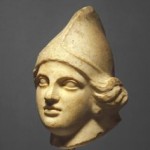By Adrienne Mayor (Regular Contributor)
 King Cleomenes and the Spartans thought their war against Argos was over. Victory was theirs! The Argive army was decimated and a few survivors had fled the battlefield into a sacred grove for refuge. Those men were easily wiped out–burned alive when the Spartan soldiers set fire to the pine trees. Now all that remained was to march on Argos and take over the city so renowned for music and poetry.
King Cleomenes and the Spartans thought their war against Argos was over. Victory was theirs! The Argive army was decimated and a few survivors had fled the battlefield into a sacred grove for refuge. Those men were easily wiped out–burned alive when the Spartan soldiers set fire to the pine trees. Now all that remained was to march on Argos and take over the city so renowned for music and poetry.
The battle (about 510-494 BC) was celebrated in Greek art and literature. According to legendary accounts recorded by Herodotus, Pausanias, and Lucian, the Argive women saved their city from the Spartan attack. Inside the city walls, a distinguished poetess named Telesilla took charge. She sent old men, young boys, and household slaves to man the walls. Meanwhile she and the women of Argos snatched up weapons and armor from houses and temples. Dressed in men’s clothes, the women massed where the Spartans were beginning the final assault. Resolute and unfazed by the Spartans’ terrifying battle cries, the women met the Spartan charge with valor, stood their ground, and fought back with surprising strength.
Now Cleomenes and his men faced a dilemma. It would be an inglorious kind of victory if they slaughtered such brave women. But on the other hand, what a shameful disaster it would be if crack Spartan warriors somehow failed to defeat the women.
The Spartans withdrew and yielded the battle to Telesilla and her forces.
Because of the women’s victory, it was said that the women of Argos worshipped Ares, the god of war. Writing about 600 years after the battle, Pausanias visited Argos and described a relief near the theater and sanctuary of Aphrodite honoring Telesilla as the poetess-warrior. She was depicted donning a helmet, with her poetry books lying at her feet. That sculpture no longer exists but tiny fragments of Telesilla’s poetry do survive; it seems that she wrote songs for girls and poems on mythic topics. Given the Amazon-like courage of Telesilla and her female recruits, perhaps it is no surprise that the beautiful head of an Amazon, pictured above, was made in Argos in the late fifth century BC.
–Adrienne Mayor is the author of The Amazons: Lives and Legends of Warrior Women across the Ancient World (2014)
